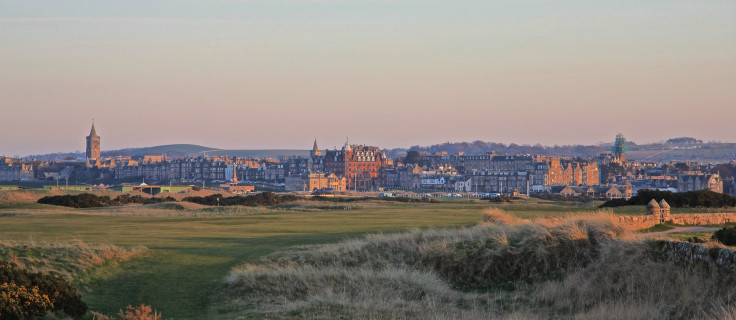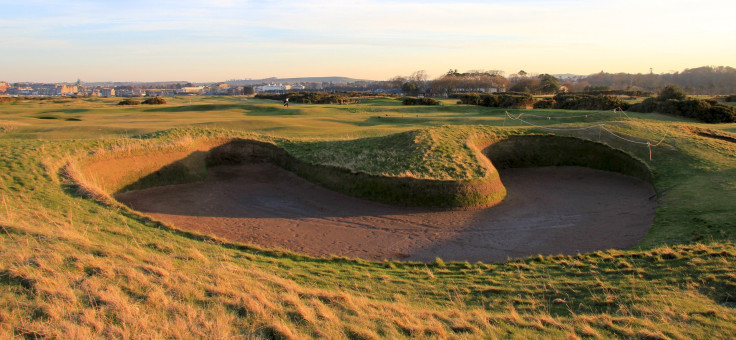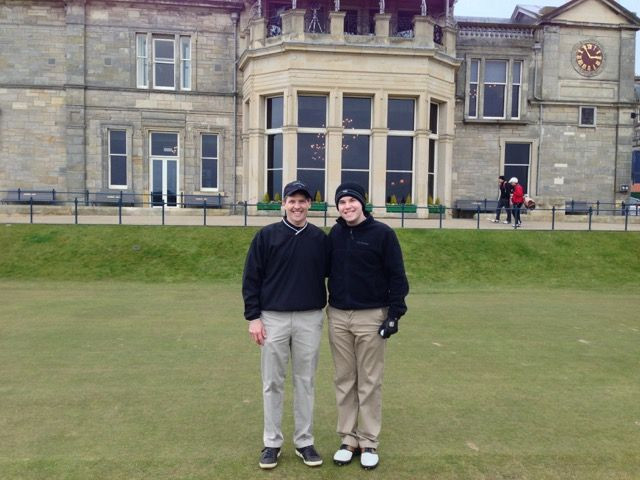British Open 2015: St. Andrews' Old Course Gives American Students Unlimited Rounds

Most college students study abroad to meet new people, expand their academic horizons and see more of the world. But for Connor Mighell, 23, the decision to spend a semester at the University of St. Andrews in Scotland centered on the holiest of sports pilgrimages: The Old Course where golf was born.
“It’s the home of golf,” Mighell said. “The first thing I packed was my golf clubs.”
With the 2015 British Open teeing off early Thursday morning, the Old Course in St. Andrews will be on display for golf fans around the world who dream of its idyllic rolling hills and someday testing their game at the birthplace of golfing. But thanks to a perhaps little known quirk that allows students and locals to buy an unlimited links ticket for about $300, some American co-eds studying abroad aware of the rule have used it to play the course countless times and upgrade their college experience.
In his few months abroad as a junior, Mighell’s dorm was a short jaunt through the ancient town to the links. And just like that, he was on the hallowed grounds of St. Andrews, where the ghost of the game flow through every swing of the club. “It was like being a fifteen-minute walk from the Vatican, it was almost a spiritual experience” Mighell said.

The lucky ticket
The process of playing as a student is relatively simple. Once you’re officially a member of the university, you can purchase a card that allows you onto any of St. Andrews’ courses. The St. Andrews Link Trust, which hands out the links tickets, operates the town's seven different golf courses, but the old course is the main draw and the one at which the British Open is often held. It's the course where golf became what it is today.
The price varies, usually rising a few pounds per year, but a links ticket to play all seven courses costs about 180 pounds, or $280. To play the Old Course, a student or local has to have a handicap of 24 or lower, which isn’t exceptionally hard (think pretty average weekend golfer) and that documentation can be procured from a local home course. The same handicap rule applies to all potential golfers as well.
From there, students can get on the daily ballot, or queue, to play the Old Course in two different blocks of tee times. It’s not difficult for students to get on and in the winter, which is outside of the popular tourist season, there’s no struggle at all.
Foreign tourists, on the other hand, have a few different options, according to Links Magazine. They can show up, after booking expensive airfare, and sign up for a daily lottery that decides if a group gets awarded a tee time. A tourist could also simply line up alone early in the morning and try to join another group that was awarded a tee-time, but that is far from guaranteed. Or a golfer can book a trip with a tour operator that costs more than $2,000 and guarantees a tee-time. This degree of difficulty and expense, coupled with the aura of the St. Andrews course in all its stony glory, makes it a once-in-a-lifetime experience for most.
But if you’re a part of the town, like students are, it’s much easier. Since the game was birthed and molded on St Andrews’ grounds, it’s treated much more like a communal right then the country club experience in the U.S. And for the reason, the course has always remained open to locals for an exceptionally affordable price.
Sunday is the only day students and townspeople cannot golf on the Old Course. Instead, the links are opened up as a public park, complete with Frisbee tossing and dog-walking. Conversly, imagine the meticulously primped lawns of Augusta trampled by a sheepdog. It would never be allowed. That difference in culture allows for the college kids abroad to experience perhaps the world’s greatest course.

The home of golf
As legend has it, golf began in 12th century Scotland with shepherds knocking stones with crooked sticks into rabbit holes. By the 15th century it grew popular and in 1552 the Old Course at St. Andrews was founded, with the town officially gaining the right to play golf on the links. Two hundred years later, the Old Course shifted from 22 holes to 18, and in the process, shaped golf into a sport that looks like the game played today.
Over time, the course sites became touchstones for the game. There's the 700-year-old Swilcan Bridge, a stone arch that crosses the Old Course's only water hazard and is the site where nearly every player stops for a photo. There's the imposingly deep Hell Bunker that features a sheer ten-foot face daring golfers to try and chip a ball over it. Or there's hole No. 17 – the Road Hole – where the green is backed by a winding road with an accompanying stone wall that serves as a backstop and impediment to swings.
Nearly every legend of the game has passed through St. Andrews, including Old Tom Morris, Bobby Jones, Arnold Palmer, Jack Nicklaus and Tiger Woods. Along the way, the Old Course took on a certain mystique. For golfers, calling the Old Course a “golf course” is akin to calling the Sistine Chapel a church.
When Graylyn Loomis was deciding where to study abroad, he was almost entirely swayed by the chance to play at St. Andrews University. Only once he enrolled did Loomis realize the university was one of the top-ranked European schools and boasted Prince William as an alumnus. Loomis spent four years at the school and estimated he played the Old Course 185 times. He likely knows its intricacies better than most of the pros playing in the British Open. And he knocked in a hole-in-one where the game took shape, something they might never do.
Loomis wrapped up his junior year of college with a quick round before flying home to North Carolina. He approached the Par-3 eighth hole, the wind shaking lush fescue toward the cup. Loomis hit a smooth, butter-cut shot with his seven-iron that drew toward the hole 171 yards away. The ball landed about ten feet short of the pin and disappeared from view, rolling hills cutting out his sightline. Loomis and his playing partner bustled up to the green expecting to see a white dot come into view, but no.
“My ball was in the hole,” Loomis said. A hole-in-one: the rare intersection of skill and fleeting luck for which every golfer waits but might never find. And at St. Andrews' Old Course.
"The idea of ... 'I’ll just hop down and play the Old Course' is hard to explain," Loomis said. "People back home didn’t really get it."

Late nights and early tee times
Alex Yabroff, a 31-year-old lawyer in Washington, D.C., graduated from the University of St. Andrews in 2005. The California native expected to do a gap year of sorts in Scotland playing a lot of golf, but never left the school. He said he and his buddies – perhaps fresh off a night out – would play the Old Course with tourists making their trek to golf’s epicenter.
“[Students] get paired up with a visiting tourist who will be on the verge of tears on 18, while the students playing with him are pretty much hungover and trying to avoid studying,” he said.
It was a rite of passage to steal the flag from the 18th hole coming home from the pub during late nights. One of Yabroff’s buddies – a scratch golfer on a semester abroad – often bragged he could hit a ball through the metal bars of his dorm room window, over an entire block and onto a green at the Old Course. His last week at the school, the friend measured the distance, pulled out an iron and thwacked away. Yabroff hid in the corner of the room, hoping not to take a ricochet on the chin. Then, miraculously, the kid pulled it off.
“On the second try he hit a perfectly clean shot out the fourth floor window over the block and on the golf course,” Yabroff said, although it wasn’t exactly perfect. “We do remind him that he actually landed the ball 15 feet left of the green.”
Yabroff ended up playing the Old Course – not from a dorm window – a couple dozen times. He remembers playing on a day with particularly nasty weather, brushing away hailstones on greens. By the end of the round the course belonged to just he and his friend. At No. 17 they stopped at the Jigger Inn, a little pub dating back to the 1850s that lines the course and crackles with hearth fires. Yabroff and his friend had a few pints, warmed up, then played the final hole. While playing the Old Course was a “moving experience,” Yabroff did have one distinct failure.
“A friend of my father said that if I came back with anything less than a 10 handicap it was a waste of my degree,” he said. He’s about an 18-handicap.

Father, son and going home
Mighell learned to play golf from his father from the age of three onwards. It was their thing and incalculable hours on the links brought them together. It took Connor going away to school for his father to finally make his pilgrimage to St. Andrews' Old Course.
During the visit, they walked to the links through quiet stone streets. Somehow, Mighell and his Dad lucked into the very first tee time that morning, meaning they would have the honor of beginning the day at the Old Course. Dad hit first.
“He got up to the ball, took a look at it, [and] he just swung away,” Mighell said. His father watched the ball fly, turned around and walked away from the tee-box. He faced his son and said, “Thank you.”
For Mighell’s dad, that was it, perhaps his one chance at St. Andrews glory. And he nailed it. As for the younger Mighell, well, if he flubbed the drive, there was always next time.
It was only when he returned home, talking with friends and family – consumed with envy and eager questions – did he realize just how lucky he had been to play golf at St. Andrews' Old Course.
“It snapped into focus for me, I will never have an opportunity like that again,” Mighell said. “It’s half way around the world but you’ve done it … you can tell [friends] I did this.”
© Copyright IBTimes 2024. All rights reserved.






















